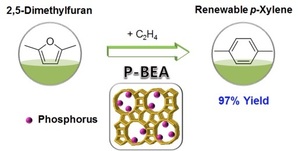
A team of chemical engineering researchers that includes professor Wei Fan, and doctoral students Hong Je Cho and Vivek Vattipalli from the University of Massachusetts Amherst, has developed a new chemical process to make p-xylene, an important ingredient of common plastics.
The new method has a 97 percent yield and uses biomass as the feedstock. P-xylene is currently produced from petroleum.
The research is featured in the current issue of the journal ChemCatChem. It is estimated that the global market for plastic products using this chemical will grow by about 5 percent annually.
The key to the new process, which builds on previous work by the research team, is a new zeolite catalyst that directs the liquid chemical reaction to produce p-xylene and discourages the production of other byproducts, Fan says.
Previous efforts to make p-xylene in this manner have not achieved a yield higher than 75 percent, he says.
Fan says the new zeolite was synthesized to contain phosphorous which helps create a much more selective chemical reaction that almost exclusively yields p-xylene.
“The phosphorous containing zeolite catalysts exhibit high surface area and well dispersed phosphorous active sites.
Different from conventional acid catalysts, the phosphorous containing zeolite catalysts is highly selective for p-xylene production.
The selectivity is unique and has not been observed in the past.
It can be easily used for many other important catalytic reactions,” Fan says.
Consumers already know the plastics made from this new process by the triangular recycling label “#1” on plastic containers.
Xylene chemicals are used to produce a plastic called PET (polyethylene terephthalate), which is currently used in many products including soda bottles, food packaging, synthetic fibers for clothing and even automotive parts, Fan says.
The ability to create p-xylene from renewable biomass is a major step in creating a commercially attractive process, Fan says.
Other members of the team are Limin Ren, Paul J. Dauenhauer and Michael Tsapatsis from the University of Minnesota, Yu-Hao Yeh and Raymond J. Gorte from the University of Pennsylvania and Nicholas Gould, Bingjun Xu and Raul Lobo from the University of Delaware.
The research team is part of the Catalysis Center for Energy Innovation that seeks to find breakthrough technologies for producing biofuels and chemicals from lignocellulosic biomass.
The center is funded by the U.S. Department of Energy as part of the Energy Frontiers Research Center program, which involves more than 20 faculty members with complementary skills to collaborate on solving the world’s most pressing energy challenges.
“Progress of the type reported in this paper exemplifies what is possible within the highly collaborative environment fostered by CCEI,” Tsapatsis says.
Author
Patrick J. Callahan
Source
UMass Amherst, press release, 2016-11-16.
Supplier
University of Delaware
University of Massachusetts Amherst
University of Minnesota
University of Pennsylvania
US Department of Energy (DoE)
Share
Renewable Carbon News – Daily Newsletter
Subscribe to our daily email newsletter – the world's leading newsletter on renewable materials and chemicals










